
Titan was a family of United States expendable rockets used between 1959 and 2005. The Titan I and Titan II were part of the US Air Force's intercontinental ballistic missile (ICBM) fleet until 1987. The space launch vehicle versions contributed the majority of the 368 Titan launches, including all the Project Gemini crewed flights of the mid-1960s. Titan vehicles were also used to lift US military payloads as well as civilian agency reconnaissance satellites and to send interplanetary scientific probes throughout the Solar System.

The Centaur is a family of rocket propelled upper stages that has been in use since 1962. It is currently produced by U.S. launch service provider United Launch Alliance, with one main active version and one version under development. The 3.05 m (10.0 ft) diameter Common Centaur/Centaur III flies as the upper stage of the Atlas V launch vehicle, and the 5.4 m (18 ft) diameter Centaur V has been developed as the upper stage of ULA's new Vulcan rocket. Centaur was the first rocket stage to use liquid hydrogen (LH2) and liquid oxygen (LOX) propellants, a high-energy combination that is ideal for upper stages but has significant handling difficulties.

The Aerobee rocket was one of the United States' most produced and productive sounding rockets. Developed by the Aerojet Corporation, the Aerobee was designed to combine the altitude and launching capability of the V-2 with the cost effectiveness and mass production of the WAC Corporal. More than 1000 Aerobees were launched between 1947 and 1985, returning vast amounts of astronomical, physical, aeronomical, and biomedical data.
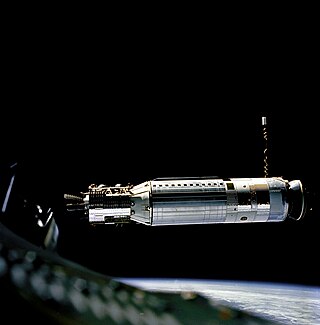
The RM-81 Agena was an American rocket upper stage and satellite bus which was developed by Lockheed Corporation initially for the canceled WS-117L reconnaissance satellite program. Following the division of WS-117L into SAMOS and Corona for image intelligence, and MIDAS for early warning, the Agena was later used as an upper stage, and an integrated component, for several programs, including Corona reconnaissance satellites and the Agena Target Vehicle used to demonstrate rendezvous and docking during Project Gemini. It was used as an upper stage on the Atlas, Thor, Thorad and Titan IIIB rockets, and considered for others including the Space Shuttle and Atlas V. A total of 365 Agena rockets were launched between February 28, 1959 and February 1987. Only 33 Agenas carried NASA payloads and the vast majority were for DoD programs.

Titan IIIB was the collective name for a number of derivatives of the Titan II ICBM and Titan III launch vehicle, modified by the addition of an Agena upper stage. It consisted of five separate rockets. The Titan-3B Agena-D was a basic Titan IIIA with an Agena D upper stage. The Titan 23B was a basic Titan II with an Agena upper stage, and the Titan 24B was the same concept, but using the slightly enlarged Titan IIIM rocket as the base. The Titan 33B was a Titan 23B with the Agena enclosed in an enlarged fairing, in order to allow larger payloads to be launched. The final member of the Titan IIIB family was the Titan 34B which was a Titan 24B with the larger fairing used on the Titan 33B.

The Titan IIIC was an expendable launch system used by the United States Air Force from 1965 until 1982. It was the first Titan booster to feature large solid rocket motors and was planned to be used as a launcher for the Dyna-Soar, though the spaceplane was cancelled before it could fly. The majority of the launcher's payloads were DoD satellites, for military communications and early warning, though one flight (ATS-6) was performed by NASA. The Titan IIIC was launched exclusively from Cape Canaveral while its sibling, the Titan IIID, was launched only from Vandenberg AFB.
Lockheed Martin Space is one of the four major business divisions of Lockheed Martin. It has its headquarters in Littleton, Colorado, with additional sites in Valley Forge, Pennsylvania; Sunnyvale, California; Santa Cruz, California; Huntsville, Alabama; and elsewhere in the United States and United Kingdom. The division currently employs about 20,000 people, and its most notable products are commercial and military satellites, space probes, missile defense systems, NASA's Orion spacecraft, and the Space Shuttle external tank.
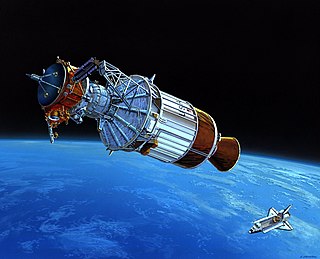
The Inertial Upper Stage (IUS), originally designated the Interim Upper Stage, was a two-stage, solid-fueled space launch system developed by Boeing for the United States Air Force beginning in 1976 for raising payloads from low Earth orbit to higher orbits or interplanetary trajectories following launch aboard a Titan 34D or Titan IV rocket as its upper stage, or from the payload bay of the Space Shuttle as a space tug.

Thorad-Agena was an American expendable launch system, derived from the Thor and Delta rockets.

The Atlas I was a US expendable launch system manufactured by General Dynamics in the 1990s to launch a variety of satellites. It was largely a commercial rebrand of the Atlas G, but did feature several electrical and guidance improvements. Atlas I did not feature any major payload capacity improvements over its predecessor but did offer a larger payload fairing option. Eleven launches took place, with three failures.
The Thor-Burner was an American expendable launch system, a member of the Thor rocket family. It consisted of a Thor missile, with one or two Burner upper stages. It was used between 1965 and 1976 to orbit a number of satellites, most commonly Defense Meteorological Satellite Program (DMSP) weather satellites. Twenty-four were launched, of which two failed. It weighed 51,810 kg and was 24 metres tall.

The Titan 34D was a United States expendable launch vehicle used to launch a number of satellites for military applications.
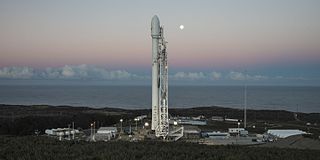
Space Launch Complex 4 (SLC-4) is a launch and landing site at Vandenberg Space Force Base, California, U.S. It has two pads, both of which are used by SpaceX for Falcon 9, one for launch operations, and the other as Landing Zone 4 (LZ-4) for SpaceX landings.

The Titan IIIA or Titan 3A was an American expendable launch system, launched four times in 1964 and 1965, to test the Transtage upper stage which was intended for use on the larger Titan IIIC. The Transtage was mounted atop two core stages derived from the Titan II. The Titan IIIA was also used as the core of the Titan IIIC.
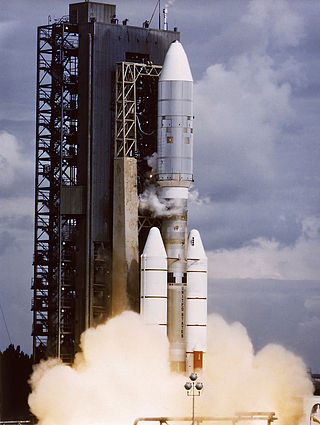
The Titan IIIE or Titan 3E, also known as the Titan III-Centaur, was an American expendable launch system. Launched seven times between 1974 and 1977, it enabled several high-profile NASA missions, including the Voyager and Viking planetary probes and the joint West Germany-U.S. Helios spacecraft. All seven launches were conducted from Cape Canaveral Air Force Station Launch Complex 41 in Cape Canaveral, Florida.
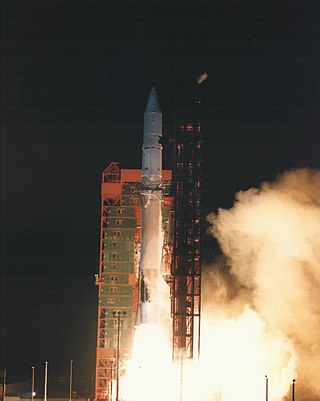
The Atlas G, also known as Atlas G Centaur-D1AR was an American expendable launch system derived from the Atlas-Centaur. It was a member of the Atlas family of rockets and was used to launch seven communication satellites during the mid to late 1980s. Atlas G consisted of an improved Atlas core with modernized avionics and stretched propellant tanks. The Centaur stage also had several updated components and other technical improvements. Atlas G flew 7 times, with all missions aiming to go to a geostationary transfer orbit. It was replaced by the near-identical Atlas I, which had an improved guidance system and offered a larger payload fairing.
The Atlas SLV-3, or SLV-3 Atlas was an American expendable launch system derived from the SM-65 Atlas / SM-65D Atlas missile. It was a member of the Atlas family of rockets.

The Titan 23G, Titan II(23)G, Titan 2(23)G or Titan II SLV was an American expendable launch system derived from the LGM-25C Titan II intercontinental ballistic missile. Retired Titan II missiles were converted by Martin Marietta, into which the Glenn L. Martin Company, which built the original Titan II, had merged. It was used to carry payloads for the United States Air Force (USAF), NASA and National Oceanic and Atmospheric Administration (NOAA). Thirteen were launched from Space Launch Complex 4W (SLC-4W) at the Vandenberg Air Force Base between 1988 and 2003.

The Titan II GLV or Gemini-Titan II was an American expendable launch system derived from the Titan II missile, which was used to launch twelve Gemini missions for NASA between 1964 and 1966. Two uncrewed launches followed by ten crewed ones were conducted from Launch Complex 19 at the Cape Canaveral Air Force Station, starting with Gemini 1 on April 8, 1964.
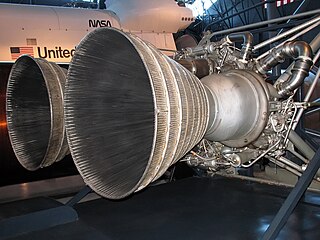
The LR87 was an American liquid-propellant rocket engine used on the first stages of Titan intercontinental ballistic missiles and launch vehicles. Composed of twin motors with separate combustion chambers and turbopump machinery, it is considered a single unit and was never flown as a single combustion chamber engine or designed for this. The LR87 first flew in 1959.


















